Here at the Personal Defense Network, we’re proud to have a diverse group of trainers contributing video material and articles. Justin White is the first of our hand-to-hand combatives experts to take part in the Instructor Profile Series.
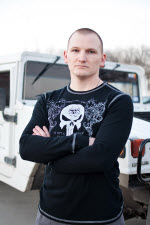
Justin White has studied the fighting arts for over 15 years. While a cadet at the Texas Maritime Academy, he began to teach. After graduating, he balanced a day job as a research scientist for the University of Minnesota with instructing and competing in professional mixed martial arts. This combination earned him the nickname “The Mad Scientist.”
Why did you decide to become a trainer?
I’ve always loved to teach and learn. Having knowledge, sharing it, and seeing that moment when a student “gets it” are incredibly fulfilling for me. As I became more skilled at fighting, it became a natural progression for me to teach. When you love to learn, teaching is a chance to relive the experience, improve your understanding of it, and know that you’re having an effect on the world.
Lots of people teach close combatives — in what ways do you teach it differently?
I place a great deal of emphasis on using angles and posture control to break down the strength of an opponent. There are positions where the body is weak and positions where it is strong; I train toward the goals of obtaining and maintaining the naturally dominant posture whenever possible. I work from the assumption that anyone attacking you is likely armed or physically larger. In general, the attacker perceives an advantage on their part, so I spend a lot of time on how to break their strength and rob them of that advantage. Essentially, I want my students to have the ability to force a larger or stronger opponent to fight on their terms.
It’s also very important to me that my students know not just how, but also why a technique or principle works. Since I used to work as a research scientist, I place great value on critical thinking and full understanding on the part of my students. If you understand both how to do it and why you’re doing it, you have a better chance of maintaining an effective practice routine.
How do you motivate students to learn while in a class? What type of person should your students expect to deal with when they train with you?
Motivation of students has never been an issue, thankfully. The folks who spend their own money to come train are already eager to learn. The challenge is motivating students to continue training and practicing in the future. Hand-to-hand skills in particular are perishable; if you don’t practice on a regular basis, the skills won’t be there when you need them. So I remind students that the concerns that brought them in in the first place don’t go away just because they got some training.
I have a very open teaching style. I like to address questions as they come and keep people focused on the context for which they’re training. I get students working on physical repetitions of skill as soon as possible, and then work around the space addressing individual concerns and corrections. This gives me a good view of which details need to be addressed for the group in question. I like to keep the pace moving and get people outside their comfort zone a bit, either with scenarios or sparring. I don’t want the first time my students try something full speed to be the first time it really counts.
Who are your inspirations?
Definitely Mike Reilly, my coach and mentor during the time I fought professionally. His approach to training had a huge effect on how I address the fight game. Also CPT Joe Proctor, my Army Combatives Instructor and the man who gave me my Black Belt in Jujitsu. CPT Proctor and I had an interesting friendship, in which he trained me on the military side while I was training him for MMA competition. He was instrumental in shifting my interests toward real-world applications of mixed martial arts and led to the unofficial motto of Mad Science MMA: “Our mixed martial arts is more ‘mixed’ than others.”
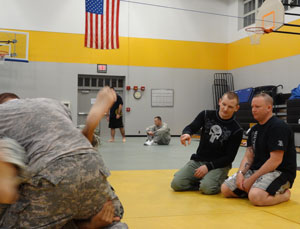
And lastly, I am inspired every day by the military personnel I’ve had the great honor to work with in the last three years.
And who do you think are some of the best instructors teaching in your field today?
I greatly admire Rob Pincus for his approach to instruction and his willingness to fill needs in the industry as he sees them. He is definitely on my short list of people I need to train with in the near future. I’ve also been impressed with Michael Janich. His material on knife stopping power, in particular, got me to change my mind on a couple things. I would also like to take training from Chris Fry and from Shivworks.
Some of the best instructors I’ve had the pleasure to work with have been military combatives trainers, in particular a pair of sergeants who came out from the JFK Special Warfare Center to train personnel at Fort Leavenworth while I was working there. These men are exceptional instructors and masters of their profession. I would love the chance to work with them again, as well.
What can students expect to take away from your courses?
I want my students to receive a foundation of skill that can be practiced and developed even after they have finished the course. I design my material so that it is not only easy to learn and perform, but so that the principles behind it can be easily understood and applied to other combative problems the student may encounter. It’s not my job to make a student feel like a warrior for a weekend. It’s my job to help them be a warrior as they go on with their lives. For this reason, I try to remain an open resource for my students after the course has concluded.
Do you have a “typical” student? What is s/he like?
By and large, my students are members of the Armed Forces, their families, or like-minded civilians. Essentially, I get to train people who realize they have skin in the game, so to speak. From a physical standpoint, my students are very diverse in age, gender and athleticism. But they all have someone close to them involved in the dangerous business of keeping our nation and streets safe, or they have assumed that role themselves for their families, so the need to be prepared for violence is very real to them.
What’s your training philosophy?
I believe anyone can learn to mount an effective defense if they are willing to put in the training time. However, I also recognize that not everyone has the same tools or athleticism at their disposal, so I try to give students as much personalized attention as I can. The principles of self-defense are universal, but you have to make sure each student can make use of them with the tools and body they have.
Looking ahead, what do you see in the future for yourself as a trainer? How about for your particular training industry?
At the moment, I’m in a brief state of transition. I’m an Army husband whose spouse has been reassigned, so Mad Science MMA is currently in the process of relocating to San Diego. This has provided me with an excellent opportunity to update my curriculum and develop new courses. I will continue writing for the Personal Defense Network, which I consider an outstanding resource and forum for students and instructors alike, and I hope to expand into instructional DVDs as well.
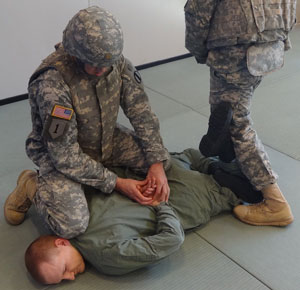
For the past three years, I have been extremely active on a volunteer basis with the Modern Army Combatives Program at Fort Leavenworth, and I hope to be as active in the military combatives programs in the San Diego area. The U.S. Army has been very good to me personally, in addition to the service they provide our nation as a whole, so giving back will always be a part of Mad Science MMA’s future.
As for the future of close combatives in the training industry, I expect to see an increased focus on hand-to-hand skills. With the popularity of mixed martial arts competition, people are realizing that highly stylized technique is not effective: that “pretty” is not as important as “works.” I also expect to see an increased emphasis on integrating hand-to-hand skills with all the tools a fighter has, to include knives, impact weapons and firearms. As the ideal of a well-rounded warrior saturates the training culture, I expect to see great things happen in the combatives field.
What is something that you’ve changed your mind about and why? Something that you used to teach but now realize isn’t the best thing to teach your students, or possibly a technique that you have replaced with something better?
One thing I’ve definitely changed my mind about is the usefulness of the small folding knife as a personal defense weapon. Previously I didn’t have much respect for small folders, largely because my earlier experience with knives came from a more military perspective, and I couldn’t see a small folder used effectively in that fashion. Once I had been exposed to some of Michael Janich’s material on knife stopping power and that approach to using small folders, which seemed more realistic to me, I began to come around on the issue. Now I regard a small folding knife, with the proper training, to be a serious self-defense option, especially for areas that restrict firearms.
Thanks to Justin for taking time out from relocating Mad Science MMA from Kansas to California to talk with PDN. Mad Science MMA’s course offerings include MMA, Combatives for CCW, Striking, and Manhandling.
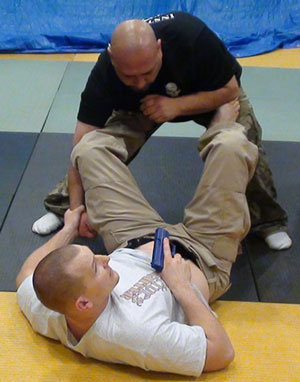
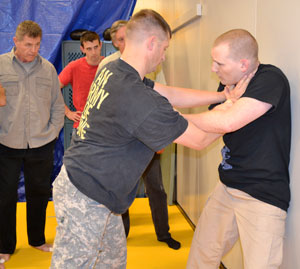

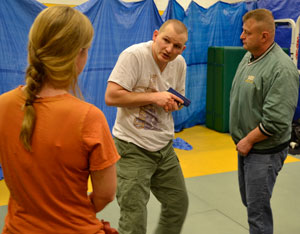

Share tips, start a discussion or ask other students a question. If you have a question for the instructor, please click here.
Already a member? Sign in
No Responses to “Justin White”